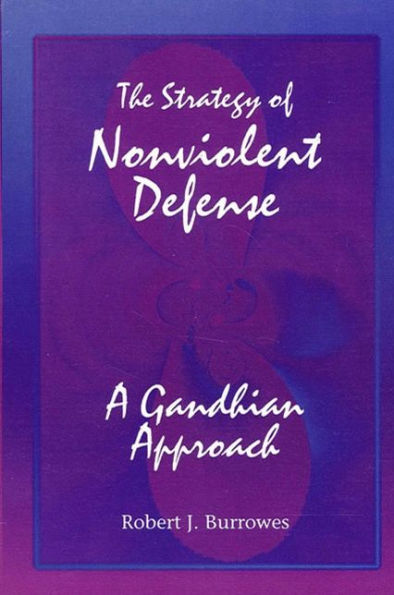5
1

The Strategy of Nonviolent Defense: A Gandhian Approach
367
by Robert J. Burrowes
Robert J. Burrowes

The Strategy of Nonviolent Defense: A Gandhian Approach
367
by Robert J. Burrowes
Robert J. Burrowes
eBook
$27.99
$36.95
Save 24%
Current price is $27.99, Original price is $36.95. You Save 24%.
Available on Compatible NOOK devices, the free NOOK App and in My Digital Library.
WANT A NOOK?
Explore Now
Related collections and offers
27.99
In Stock
Overview
Because of the way in which the history of nonviolence has been marginalized, relatively few people have a sense of the rich history of nonviolent struggle or realize that it can be systematically planned and applied. Nevertheless, the historical record illustrates that nonviolent struggle is a powerful form of political action. But can it be effective against military aggression?
The Strategy of Nonviolent Defense answers this question in the affirmative by first defining the notion of "social cosmology"—the four mutually reinforcing features that determine the character of any society. It then devotes attention to strategies for dealing with conflict, in particular, to developing a strategic theory and framework for planning a strategy of nonviolent defense. In order to develop this theory, Burrowes synthesizes insights drawn from the strategic theory of Carl von Clausewitz, the nonviolence of Mahatma Gandhi, and recent human needs and conflict theory.
The Strategy of Nonviolent Defense answers this question in the affirmative by first defining the notion of "social cosmology"—the four mutually reinforcing features that determine the character of any society. It then devotes attention to strategies for dealing with conflict, in particular, to developing a strategic theory and framework for planning a strategy of nonviolent defense. In order to develop this theory, Burrowes synthesizes insights drawn from the strategic theory of Carl von Clausewitz, the nonviolence of Mahatma Gandhi, and recent human needs and conflict theory.

Product Details
| ISBN-13: | 9780791498088 |
|---|---|
| Publisher: | State University of New York Press |
| Publication date: | 10/26/2015 |
| Sold by: | Barnes & Noble |
| Format: | eBook |
| Pages: | 367 |
| File size: | 2 MB |
About the Author
Robert J. Burrowes has been a member of the Australian Nonviolence Network since 1981 and has been involved in many nonviolent action campaigns. He is best known for his war tax resistance, his involvement in the campaign of the Melbourne Rainforest Action Group, and his membership in the Gulf Peace Team. He now devotes all of his time to nonviolent activism, education, and research.
Table of Contents
AcknowledgmentsIntroduction
The Social Cosmology
The Strategic Theory and the Strategic Framework
What Is Nonviolent Defense?
Methodology
The Structure of the Argument
1. The Strategic Theory of Clausewitz
2. Conceptions of Strategy
The Indirect Approach
Are There Universal Principles of Strategy?
The Importance of Psychology
The Dimensions of Strategy
3. Conceptions of Society
4. Human Nature and Human Needs
The Dominant Conception of Human Nature
The Importance of Human Needs
Individuals and Their Identity Groups
Conclusion
5. Conflict Resolution through Problem Solving
The Dominant Conception of Conflict
Burton's Theory of Conflict
Galtung's Theory of Conflict
Conflict Insights Derived from Psychology
The Origins of International Conflict
The Levels at Which Conflict May Be Resolved
Problem Solving as an Approach to Conflict
Needs or Power?
6. The Nature of Power
The Consent Theory of Power
The Structural Theory of Power
Conclusion
7. The Gandhian Conception of Nonviolence
Four Major Approaches to Nonviolence
The Gandhian Conceptions of Society and the Individual
The Gandhian Conceptions of Conflict and Nonviolence
The Reformist and Pragmatic Approaches to Nonviolent Action
The Importance of Power and Will
Nonviolent Action and Coercion
Conclusion
8. The Strategic Theory and Framework of Nonviolent Defense
The Strategic Theory of Nonviolent Defense
The Strategic Framework of Nonviolent Defense
Conclusion
9. The Search for Security
Feminist Perspectives on Security
Indigenous Peoples' Perspectives on Security
The South's Perspective on Security
The Deep Ecological Perspective on Security
Cooperative Security
10. The Strategic Theory of Nonviolent Defense
Two Conceptions of "Nonviolent Defense"
Arguments against Civilian-Based Defense
Military Aggression and Nonviolent Defense
The Strategic Theory of Nonviolent Defense
Shortcomings in the Strategic Orientation of Civilian-Based Defense
11. Planning and Organizing Nonviolent Defense
Strategic Planning
The Political and Strategic Assessment
The Conception of Nonviolence
Organization
Leadership
Internal Communication
Advance Preparations
The Constructive Program
Evaluation
12. The Strategy and Tactics of Nonviolent Defense
The Political Purpose and the Strategic Aims
The Strategic Timeframe
Communication
Strategic Considerations in the Selection of Nonviolent Tactics
Secrecy and Sabotage
Peacekeeping
Nonviolent Defense Against an Extremely Ruthless Opponent
13. The Strategic Counteroffensive
The Opponent Elite's Will
Economic Sanctions
The First Domain: The Opponent Elite's Troops
The Second Domain: The Opponent Elite's Domestic Constituency
The Third Domain: The Domestic Constituencies of Allied Elites
Solidarity Action
Conclusion
Conclusion
Notes
Bibliography
Index
From the B&N Reads Blog
Page 1 of
